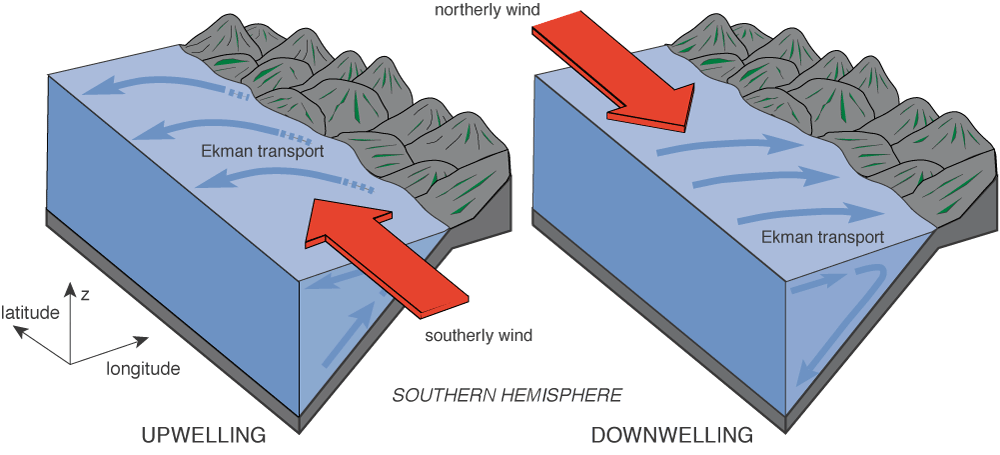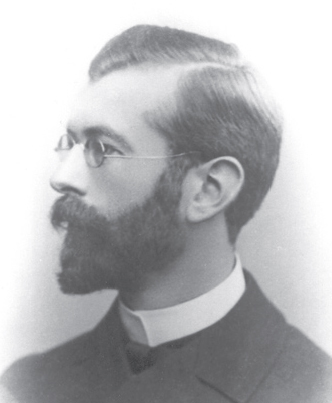Table of Contents
Ekman Transport
Authors: Anna Muntwyler, Ana Cristina Franco Novela
The term Ekman transport refers to the volume of water in the surface layer (layer affected by wind) of the ocean that is transported at right angles to the wind direction. The direction of transport occurs at 90° to the right from the direction of the wind in the northern hemisphere and to the left in the southern hemisphere.
The concept was introduced by Vagn Walfried Ekman in 1902, and is part of the Ekman motion theory. The Ekman theory explains the theoretical state of circulation if water currents were driven only by the transfer of momentum from the wind. The total transport resulting from a balance between the Coriolis force and frictional stress at the bottom.
Ekman layer and Ekman spiral
Steady winds blowing on the sea surface produce a thin, horizontal boundary layer, the Ekman layer. The depth of this layer is defined as the depth in which the direction of the current is opposite the velocity in the surface.
The Ekman spiral refers to a structure of currents or winds near a horizontal boundary in which the flow direction rotates as one moves away from the boundary.The effect is a consequence of the Coriolis effect which subjects moving objects to a force to the right of their direction of motion in the northern hemisphere (and to the left in the Southern Hemisphere). Thus, when a persistent wind blows over an extended area of the ocean surface in the northern hemisphere, it causes a surface current which accelerates in that direction, which then experiences a Coriolis force and acceleration to the right of the wind: the current will turn gradually to the right as it gains speed. Eventually, the current will reach a top speed when the force of the wind, of the Coriolis effect, and the resistant drag of the subsurface water balance, and the current will flow at a constant speed and direction as long as the wind persists. This surface current drags on the water layer below it, applying a force in its own direction of motion to that layer, repeating the process whereby that layer eventually becomes a steady current even further to the right of the wind, and so on for deeper layers of water, resulting in a continuous rotation (or spiraling) of current direction with changing depth. As depth increases, the force transmitted from the driving wind declines and thus the speed of the resultant steady current decreases.
Examples
In the continental boundaries, if the wind blows in a way that Ekman transport moves water away from the coast (to the south in the Northern Hemisphere and to the North in the Southern Hemisphere), then water from below is pumped to the surface due to mass conservation. On the other hand, if the wind blows in a way that Ekman transport moves water towards the coast, then the water is piled up near the coast and downwelling occurs.
Figure 2. Example of upwelling and downwelling caused by Ekman transport in the Northern Hemisphere.
History
This phenomenon was first mentioned by the Norwegian scientist Fridtjof Nansen, who recorded that ice transport appeared to occur at an angle to the wind direction during his Arctic expedition in the 1890s. In 1905 he supplied the Swedish physicist Vagn Walfrid Ekman with the data which established the principle in oceanography known as the Ekman spiral.Based on Nansen's observations of ocean currents recorded during the Fram expedition, Ekman concluded that the effect of wind on the sea's surface produced currents which “formed something like a spiral staircase, down towards the depths”.
Equations and units
Here a summary of the most important Equations:
Ekman layer thickness $D_E$, i.e. the depth of frictional influence of the wind. Below this depth the wind has no effect:
$D_E = \sqrt{\frac{2K_z}{f\rho}} $
Magnitude of the depth mean current (averaged) and which is at right angles to the wind direction: $\overline{u} = \frac{\tau_0}{D_E \rho f}$
Ekman volume transport can be calculated by multiplying the magnitude of the depth mean current by the thickness of the wind-driven layer. Its units are $m^3 s^{-1}$ On the other hand, the Ekman mass transport, which has units of $kg m^{-1} s^{-1}$, is the mass transport or water that occurs every second in a 1 m wide section of the water column.
Ekman transport:
$\vec{U}_E = -\frac{1}{\rho f}\vec{e}_z \times \vec{\tau}_0$
Sources
http://en.wikipedia.org/wiki/Ekman_transport. Retrieved 29.04.2014
http://en.wikipedia.org/wiki/Vagn_Walfrid_Ekman. Retrieved 29.04.2014
Colling, A., Ocean Circulation, Open University Course Team. Second Edition. 2001. ISBN 978-0-7506-5278-0
Knauss, J.A., Introduction to Physical Oceanography, Waveland Press. Second Edition. 2005. ISBN 978-1-57766-429-1
Münnich, M. (2014): Introduction to Physical Oceanography:Lecture 8
Sarmiento J.L and N. Gruber. Ocean Biogeochemical Dynamics. Princeton University Press. 2006. 503 pp.
Stewart, R. H., Introduction To Physical Oceanography, Department of Oceanography Texas A & M University September 2008 Edition
“AMS Glossary”. Retrieved 29.04.2014
Tasks
- Add example(s) of open ocean up- or downwelling (e.g. in subtropical gyres or the Southern Ocean)


